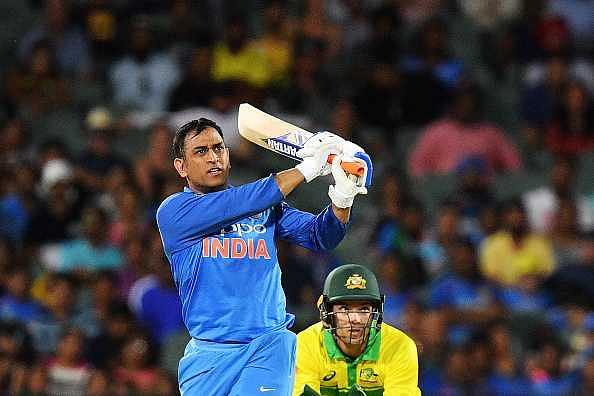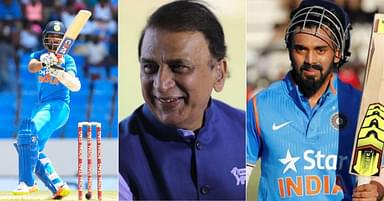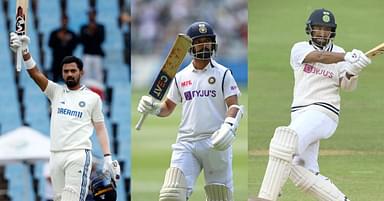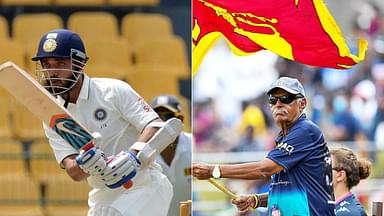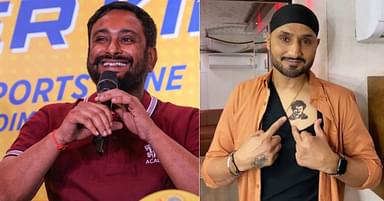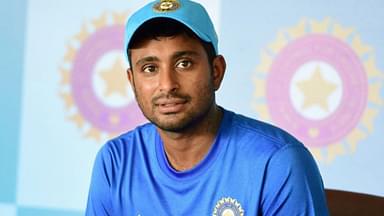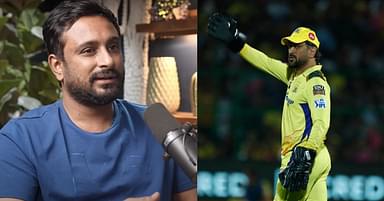MS Dhoni should bat at No. 4 for India: Sportsrush presents before you detailed analysis of India’s No. 4 conundrum.
“Options are still there. Let’s see what happens,” former India captain Sourav Ganguly was quoted as saying to the reporters at the Eden Gardens in Kolkata on Monday after India conceded 359 runs in less than 48 overs in the fourth ODI against Australia.
Advertisement
While Ganguly sounded unperturbed by the Indian defeat, he surely oozed uncertainty regarding India’s No. 4 for the ICC Cricket World Cup 2019. Given the potential which contemporary Indian batsmen possess, finding a suitable No. 4 batsman should have never become a pressing worry like it is now.
While players are generally blamed for a team’s performance, the scenario with India’s No. 4 finds the team management and selectors equally at fault. Not persisting with players who show promise and continual chopping and changing in the name of tackling with the situation have put the Indian team on tenterhooks.
Since the ICC Cricket World Cup 2015, India have played as many as 11 batsmen at No. 4. In this period, whosoever could possibly bat at No. 4 eventually ended up batting at No. 4. The Indian Playing XI at No. 4 includes Ajinkya Rahane, Mahendra Singh Dhoni, Manoj Tiwary, Virat Kohli, Manish Pandey, Yuvraj Singh, Hardik Pandya, Dinesh Karthik, Kedar Jadhav, Lokesh Rahul and Ambati Rayudu.

When and how exactly did the No. 4 trouble begin?
It is worth mentioning that the problem had persisted even before the world event in 2015. In the build-up to the tournament, India’s No. 4 spot had shuffled between Rahane, Rayudu and Suresh Raina. During the tournament, the battle was won in a one-sided manner by Rahane, who batted at No. 4 on six occasions as compared to Raina batting just once.
The musical chairs continued after the World Cup as Dhoni, Tiwary and Kohli joined the race to bat at No. 4 as the year progressed. The start of 2016 saw India playing a five-match ODI series in Australia. While Dhoni batted at No. 4 in the first ODI at Perth, Rahane scored a couple of half-centuries at a strike rate of 102.96 in the next two ODIs.
Chasing 349 runs in the fourth ODI at Canberra, India required 72 runs off 75 balls when the second wicket fell. Rahane was surprisingly demoted from No. 4 to No. 7 as Dhoni, Gurkeerat Singh Mann and Ravindra Jadeja batted ahead of him. India eventually lost the match by 25 runs.
From a couple of half-centuries to getting dropped…
In the last ODI at Sydney, Rahane found himself outside the playing XI as Pandey was brought in. Having scored a match-winning 104* (81) in a 331-run chase, Pandey gave the impression of becoming India’s long-term No. 4 but even that was not to be. Excluding his century at No. 4, Pandey scored 79 runs in seven ODIs at a paltry average of 15.80 and a strike rate of 68.10.
The first half of 2017 welcomed veteran all-rounder Yuvraj Singh back into the ODI squad after more than three years. In the 10 matches which the southpaw played during this time, he scored 358 runs at an average of 44.75 and a strike rate of 97.54. Not including his career-best 150 against England at Cuttack, Yuvraj had scored 208 runs in nine matches at an average of 29.71 and a strike rate of 86.66.
Ambati Rayudu looked the most settled at No. 4
For nearly a year, India introduced Pandya, Karthik, Jadhav and Rahul to the No. 4 spot before Rayudu was recalled into the side during the Asia Cup last year. Since his comeback, Rayudu has scored 464 runs at an average of 42.18 and a strike rate of 85.60 including one century and two half-centuries at No. 4.
Just when Rayudu was looking set to make this position his own, he has currently suffered a dip in form this year. An average of 30.87 and a strike rate of 75.30 in association with Vijay Shankar making optimum use of his opportunities have gone against Rayudu.
Another facet which has duly affected the Indian team is cut-throat competition in the ODI side. Just when someone goes through a slightly rough patch, there are several other players who look ready to replace him. As highly as it speaks of our bench strength and flexibility, it is somewhere also responsible for this situation.
With India standing their ground on ceaselessly making changes to their No. 4 since the last half-a-decade, the conundrum they are facing now is just a mere outcome of their own miscalculations.
What next for Team India?
Despite him being dropped from the last ODI at Mohali, any patient mind will suggest India to continue with Rayudu for the World Cup. His overall numbers doubtlessly press his case for flying to England in May. However, it will also go down as a conservative approach in a bid to not disturb the combination at this point in time.
Digging more into numbers, one finds that Rayudu might not be the best player for India at No. 4 going into the World Cup. Bringing into play the impact which the recent Indian No. 4 batsmen have generated during their presence in the middle, one comes across a different conclusion altogether.
A simple percentage of how many runs these batsmen have scored since the 2015 World Cup at No. 4 with respect to how many runs the team scored during the same period gives us a better view of who has contributed in the best manner at No. 4.
Starting with Rayudu, the 33-year old batsman has scored 464 runs off 542 balls while batting at No. 4 for India. During the time when he was in the middle, India have scored 1,002 runs off 1,052 balls. While Rayudu scored 46.30% of the total runs, he faced 51.52% of deliveries.
Ajinkya Rahane, anyone?
In a recent interview with Mumbai Mirror, former India batsman Dilip Vengsarkar advocated for the Indian selectors picking Ajinkya Rahane to bat at No. 4 and also keep him as a reserve opener.
“Ajinkya will give the middle order the much-needed solidity besides the option as an opening batsman too as he has the experience of opening and also batting at No 4. Mind you, it’s not a Twenty20 tournament but the 50-over World Cup where building a team total will decide the fate of the teams,” Vengsarkar was quoted as saying.
Rahane had last played for India in ODIs during the tour of South Africa a year ago. In what is a curious case, Rahane might have been hard done by how he has been shifted up and down and in and out of the squad but he somewhere has himself to blame for his overall ODI average of 35.26 and a strike rate of 78.63.
With the interview happening in the recent times, we thought of going through Rahane’s numbers as well. Contrary to his overall strike rate, Rahane has scored 420 runs off 453 balls at a strike rate of 92.71. During his time in the middle, India have scored 922 (905) which comes down to him scoring 45.55% of runs and playing 50.05% of balls.
Among Rayudu and Rahane, the latter takes a slender lead but recalling him will require a great amount of fortitude on the part of the selectors.
Who else is eligible?
When the same method was applied on Lokesh Rahul and Dinesh Karthik, both of them portrayed below par numbers.
While Karthik has scored 40.49% of runs and faced 48.36% of deliveries during his time in the middle at No. 4, Rahul has scored 29.54% of runs and faced 44% of deliveries. Having played only three innings at No. 4, one can’t really blame the latter.
Can MS Dhoni bat at No. 4?
This discussion would be incomplete without bringing Dhoni into contention. Given his stature, several current and former cricketers in VVS Laxman, Anil Kumble, Suresh Raina, Bhuvneshwar Kumar, Rohit Sharma and Sanjay Manjrekar have passed judgement on where the legendary cricketer should bat during the showpiece event.
“I am happy to bat at any number,” Dhoni had said after winning the ‘Man of the Series’ award during the ODI series in Australia earlier this year. Dhoni at No. 4 might sound to be unrealistic with the current combination, but the certitude is that he has fared better than the current options at No. 4.
In the same period, Dhoni has scored 448 runs off 553 balls while batting at No. 4. In his presence, the team has scored 780 runs off 1,071 balls. While Dhoni has faced almost a similar number of deliveries (51.63%) as Rayudu and Rahane, his scoring percentage of 57.43% is way above anyone else.
It is true that Dhoni slows the game in the middle but India have middle-order batsmen who have it in them to press the accelerator during the business end of the innings. Furthermore, someone of Dhoni’s composure will be apt in times of a batting collapse.
The question which arises now is that who will bat at No. 5 if Dhoni bats at No. 4? If the team management decides to play Dhoni at No. 4, one out of Rayudu, Karthik or Vijay Shankar could play at No. 5. Whether the Indian team management will take such a major decision during the biggest ODI tournament is something really intriguing and worth looking forward to.
How Twitter reacted:
51 in Sydney
55* in Adelaide
87* in Melbourne@msdhoni is the Player of the Series! #AUSvIND pic.twitter.com/VBdzXt9MsE— ICC (@ICC) January 18, 2019
Less than two months after sealing a tight chase in Melbourne, MS Dhoni and Kedar Jadhav were at it againhttps://t.co/nrn5WOMQcA #INDvAUS pic.twitter.com/tTjk2kVmaX
— ESPNcricinfo (@ESPNcricinfo) March 3, 2019
It’s in India or in Overseas
It’s in Australia or in New Zealand
It’s in Melbourne or in AucklandCraze for #MSDhoni remain always same
I LOVE DHONI
WE LOVE DHONI
INDIA LOVE DHONI
WORLD LOVE DHONIMost Popular Cricketer Ever!! 💙💕#NZvInd pic.twitter.com/oTZCnQhlt0
— Msd’s Pradip (@PradipMsd7) February 8, 2019
”Every City he goes to it becomes his hometown” – Jatin Sapru said this abt MSDhoni in Imagine Recreation!
Proof: A Glimpse of @msdhoni chants in Melbourne 😎!!#MSD pic.twitter.com/vYJd1UfiJS
— Vidyadhar R (@Vidyadhar_7) January 19, 2019
Melbourne was a sea of blue and Dhoni-haters saw red! Well done @msdhoni, @JadhavKedar and India.👏👏👏👏
— Mohan Sinha🇮🇳 (@Mohansinha) January 18, 2019
For more cricket-related news, click here.

